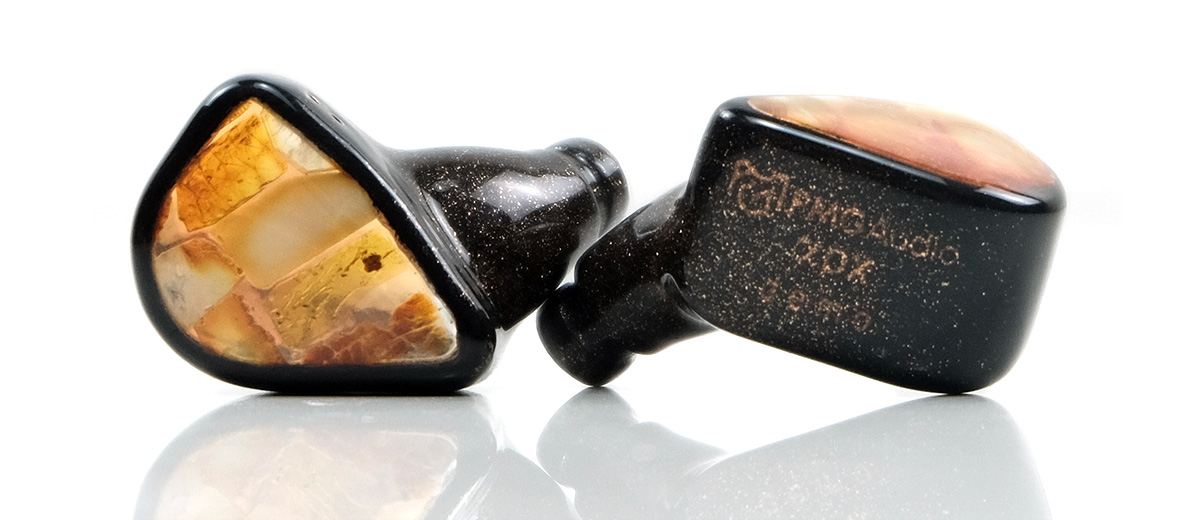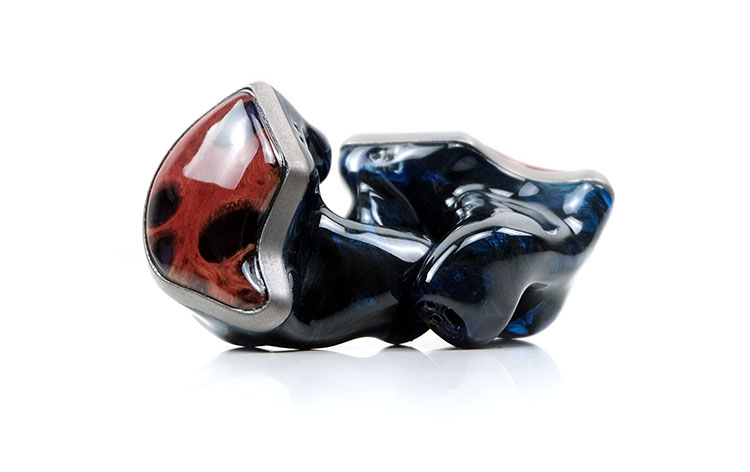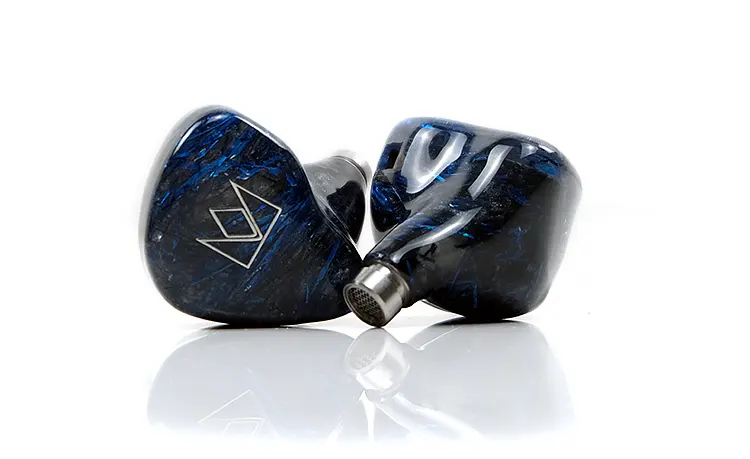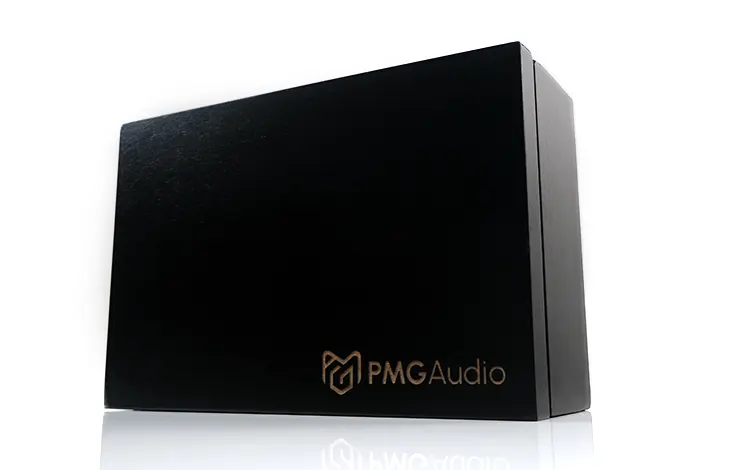Selected Comparisons
The following comparisons to the PMG Audio Apx were completed using a mix of the iBasso DX320 MAX Ti, the Cayin N8ii, and the HiBy R8 II for both source and amplification. All compared IEMs were using stock cables and ear tips, (silicone for the Apx).
Unique Melody Multiverse Mentor
The Unique Melody Multiverse Mentor was launched in early 2023 with our full review later that year. It was also the Top Gear winner for Best Custom IEM in the same year. You can also buy it in a universal format.
Technical
These are both hybrid monitors and though the count is close at 11 vs 12, (Mentor), the direction and mix of the drivers is quite different.
The Multiverse Mentor has no planar or dynamic. Instead, it uses an all-BA driver configuration with an additional Frequency Shift piezoelectric bone conduction driver.
That will create a very different type of texture and timbre to notes when stacked up against the planar/dynamic low-end of the Apx and again in the ultra-highs with the PMG smaller round planar.
The mids for both are BA though the split is different with the Mentor using 2 for the mids, 2 more for the mid-highs, and 4 for the highs and ultra-highs with a 5-way crossover. The Apx uses a 7-way passive crossover with 8 custom balanced armature drivers in 4 dual configs for the lower-mids, mids, mids/lower-highs, and highs.
UM has placed less of a focus, at least on the marketing level, on the acoustical engineering side of the Multiverse Mentor which is in stark contrast to the Apx’s raft of implementations such as POD, 3D, and GSO, (see page 1 for more in-depth explanations).
The Multiverse Mentor is rated at 22Ω with an SPL of 114 dB/mW @1KHz which is slightly heavier than the 5Ω load of the Apx though its SPL at 107 dB/mW @1kHz will mean you will perceive it as the less sensitive of the two for volume and gain.
Design
The Multiverse Mentor sample we have here is a custom format but the color and design scheme are the same as one of the possible universal format designs, (orange-purple).
There was a bit of controversy about the MM design as the graphics UM marketing put looked nothing like the final physical product. Having said that, the finished design is attractive enough but just not as dynamic as it could have been.
That is not the case with the Apx with its real amber finishing which is every bit as good as the pictures suggest it might be. It does also seem to be a bit more ‘unique’ looking if you pardon the ironic pun in this comparison.
Of course, with a custom format, the MM is going to be light years ahead for fitting and isolation. It is a much bigger unit, you will feel its presence more in your ear but if done correctly its contoured body will fit your ear perfectly.
Since there is no dynamic driver inside the Mentor there is also no venting required which means a much stronger seal and superior passive isolation compared to the hybrid Apx.
The quality of the Multiverse Mentor The Deep of Universe is insanely good. It does not have the functionality of the Apx Omega cable’s interchangeable plug system but it does have more visual pop with its matching fabric jacket finish and deeply contoured barrels.
The arguments for the Apx cable beyond the plug system are that it is lighter and just as silent for microphonics. Technically, it is also a 4-wire mix of copper and silver though it is an alloy whereas the MM version is independently shielded ultra-pure copper and silver-plated copper wire.
Performance
Two hugely contrasting performances here and to be frank, they can make the same song sound completely different when played through each monitor.
The Mentor is the king of smooth, with a coherent rounded tone and an impressively spacious sound stage. It’s more on the relaxed side and beautiful for soulful performances or for those who want a less aggressive treble presentation.
The Apx sounds more arena-like, with a deeper staging quality, a slightly lighter but more energetic note tone through the upper mids, and tons more sparkle in the highs.
It also stretches impressively wider in its presentation, particularly with layered backing vocals, which surprised me considering how good the MM is already.
The MM has great lows for a BA IEM but cannot match the Apx planar/dynamic driver combo for sheer sub-bass depth and physicality.
Its mid-to-upper bass amplitude is higher than the Apx from 80Hz up to around 100Hz so it carries more comparative warmth into the mids as well as bumping some vocals a little further forward around 1-2k.
Beyond 2k, however, the MM does not convey the same forward energy as the Apx which sounds more extended and airier through the upper mids and highs.
Some of the Apx’s timbre is more accurate, particularly up to 1-2k but beyond can sound more aggressive and brighter. The Mentor can sound overly rounded and lacking in comparative energy through the upper mids which cuts some of the air out giving it a denser sound.
Overall, the Apx is the better IEM on a technical level sounding more resolving and holographic with the MM sounding the smoother, and more forgiving alternative.
Noble Audio Ronin
The Noble Audio Ronin was launched at the start of 2023 with our review in the middle of the same year. It was also our Top Gear 2023 Best Universal IEM co-awardee.
Technical
The Noble Audio Ronin is a hybrid BA and EST 12 driver IEM so there is again, no dynamic or planar driver mix in this monitor and, yet another type of driver timbre for the highs.
The specific driver grouping is 4 Sonion BA drivers for the sub-bass and bass, 4 Knowles full-range drivers for the lower mids and mids, and a quad Sonion EST driver array for the highs and super highs.
Noble always keeps their internal acoustical engineering technology very close to their chests so there is not much more I can bring to the table internally other than some raw numbers including an SPL of 114 dB/mW and an impedance rating of 17Ω.
It’s the sensitivity rating here more than the comparable loads that you would want to focus on between these two IEMs.
Neither the Apx nor the Ronin is going to give you load issues, more so the Apx with its FIBAE tech which should cancel out any impedance output mismatching.
At 107 dB/mW @1kHz the Apx will require a bit more volume or gain to match the Ronin’s comparable volume levels making the Noble design a little more sensitive.
Design
Both designs are beautiful which is not surprising really since both companies, (think Custom Art), have a long history in custom monitors and put great emphasis on their design side.
They are strikingly different though with the cool blue of the Ronin a high contrast alternative to the warm real amber ambiance of the Apx.
The Ronin finish is a mix of blush nebula or marble brush strokes with a speckled layer on a smokey black underlay. This covers both plate and shell giving it a nice homogenous vibe that I tend to prefer over a highly separated plate and shell look.
Not that the Apx has a highly-separated design aesthetic but it is more separated compared to the Ronin. The speckled finish is something they both have in common.
Another huge contrast is the form factor and here Noble has often been the more polarizing of the two firms in how they approach shapes and sizes. The Ronin is by far the bigger of the two IEMs and will stick out of your ear by a country mile compared to the lower profile of the elongated narrower Apx.
Having said that, the fit of both is secure and the isolation from the Ronin is superior. Noble always does well with its nozzle designs and the Ronin is no exception but the isolation is more from the lack of venting in its shell which holds the Apx back from achieving the same level.
One final nod to the Ronin x Eletech cable collab. It’s much like the Omega with a 26AWG 4-wire Litz geometry but the Gold Plated OCC, OCC Copper, and silver-plated OCC Copper mix is more exotic and the barrel finishing more complex. Still, it lacks the Apx cable interchangeable plugs which some might prefer.
Performance
On a macro level, the Ronin matches the Apx for the effortless manner in which notes diffuse from impact without feeling walled in.
However, in terms of depth and layering, particularly for note dynamics, the Apx comes out on top. There may also be a resolution advantage here for the way the Apx details note texture compared to the Ronin.
The use of the dynamic and planar drivers in the Apx seems to shape the character of the notes a bit more than the Ronin. Those driver choices allow PMG to tune certain key aspects of the Apx presentation with more incisiveness making them more ‘interesting sounding’.
For example, the lows have more impact and a longer decay with the planar and dynamic and thus create more power and a better fundamental. Low-end instruments have more authority and stand out more.
Conversely, Ronin’s EST drivers are more on the polite side. While its highs are equally as extended if not more so, the tone ‘tickles your senses’ in a polite complementary manner rather than grabbing your undivided attention like the Apx.
The benefit of the Ronin tuning is that it’s beautifully coherent, perhaps more so than the Apx with its predominantly BA driver design.
Vocals have gorgeous weight and a sweet timbre making it an enchanting and intricate listening experience if you do not need huge amounts of bass. The Apx is cooler and more neutral though the mids and lacks that same sweetness.
Overall, the Apx is the more immersive of the two IEMs. It offers stronger dynamics, and on balance, a better technical performance. Its drivers are tuned to give you a more detailed insight into any performance compared to the Ronin.
Vision Ears Phönix
The Vision Ears Phönix is the elder of the bunch of IEMs compared here. Launched in 2021, we reviewed it in early 2022 and it won our Top Gear Award for Best Universal IEM in the same year.
Technical
The Phönix takes a more traditional route compared to the Apx with an all-BA driver compliment as opposed to mixing in dynamic or planar. It does pack in more drivers if that is your thing at 13 per shell.
The precise configuration is 4 for the lows, 4 for the mids, 4 for the highs, and then an entirely new super tweeter for the ultra-highs, primarily for air and perceived staging headroom with a passive 5-way crossover.
Like the Apx, the drivers are custom-designed with the Phönix using a mix of stacked and vented dual-driver modules, more traditional non-vented versions for the mids, and a spout-free super tweeter positioned right in the nozzle itself.
The Phönix dual driver stacks are tubed as opposed to the Apx shell construction which has the bores printed right into the design
The Phönix is rated 13Ω @ 1KHz and 125 dB/mW SPL which puts it in the super-sensitive IEM category compared to the 5Ω and 107 dB/mW @1kHz rating of the Apx. In short, the Phönix is more sensitive to volume and gain.
Design
Gorgeous designs from both companies but then you should expect that at these lofty price points. Bonus points go to Vision Ears though for the equally exquisite packaging experience, which I feel PGM Audio could look to refine the experience further.
Both IEMs are very close in size with the Phönix having a slightly flatter main shell and somewhat of a narrower nozzle build. The aesthetic is quite different though with the Phonix giving off more of a boutique jewelry-type vibe compared to the more organic natural amber tones of the Apx.
Comfort is very similar though tips will have more influence considering their smaller size. I use the stock AZLA silicone tips for the Phönix that create an excellent seal.
However, they also brighten up the sound a bit more which I feel is an essential factor in getting the best sound out of this otherwise warmish monitor.
The Apx will isolate a little bit less but no surprise here since the all-BA nature of the Phönix means it has no venting thus no leakage. Both use flush 2-pin 0.78mm pin sockets to keep the curving smooth and unobtrusive.
Although aesthetically quite different, both cables are almost identical for wiring with the Phönix also using a 4-wire silver-gold alloy with an OCC copper Litz geometry.
I prefer the finishing on the outer of the Phönix stock cable but it lacks the more useful interchangeable jack system from the Apx’s stock Omega cable.
Performance
If the Apx presentation was akin to a fireworks show outside the front door then the Phönix is a gentle fireside story inside the house.
The former is expressive, stretched, and beautifully layered, with impressive depth and height whereas the latter is more embracing, and gentile in its performance. It invites you in to relax with an intimate and smooth vocal delivery.
To be honest, I would want both side by side because they are so different and present the music in such a different but no less impressive manner. The question what appeals to you the most?
On a more objective level, no question that the Apx scales band layers on another level with more space, air, and precision.
Its dynamic/planar combo generates more sub-bass power when required, though the Phönix’s solid mid-bass punch and elevated upper-bass offer improved sustain in notes through the lower mids.
Vocals are more upfront on the Phönix and sweeter sounding but the better separation from the main staging instruments comes from the Apx. Some of the imaging on the Apx is jaw-dropping in terms of placement creating a much more complex presentation.
The Apx highs have more perceived extension and presence making the Phönix more relaxed and rounded in its tone and offering less air to create the same level of note separation.
The Apx is technically more capable but less forgiving and requires a bit more of a studied matchup for source and music. What Phönix has got is timbral coherence. It is an effortless and forgiving listening experience for everything bar strong EDM and arena-type rock music.
Our Verdict
The PMG Audio Apx to my ears is probably the most technically capable high-end in-ear monitor I have heard to date. It not only projects a huge soundstage but also a complex and resolving one reinforced by some incredible dynamic range if paired with an equally capable source.
It looks great with the unique amber materials, and its small size fits great in the ear, especially with the silicone tips making it an IEM you could wear for hours without physical fatigue.
If I am being picky, which I am, then I would say the packaging could do with a bit more ‘vision’ a stronger message or theme with more focus, if that makes sense. It has grandeur in a way but lacks character.
There will also be some that will quibble over the coloration in the highs. Especially, if like me, you enjoy the silicone tips and clean dynamic sources. Give it time to calm down, use some PMEQ, or switch to the foams if you must.
The highs of the Apx are the only potential weakness of an otherwise spectacular and memorable in-ear tour de force.
PMG Audio Apx Technical Specifications
- Drivers: 11 custom Drivers – 1x Rectangular Planar, 1x 10mm DD, 8xBA, 1x Round Planar
- Crossover: True 7-way passive crossover
- Impedance: 5Ω ±1Ω
- Sensitivity: 107dB @1kHz
- Frequency Response: 3Hz-20kHz
- Cable: Silver-copper alloy with Graphene core cable, 2.5, 3.5, 4.4mm connectors, 0.1Ω resistance.






